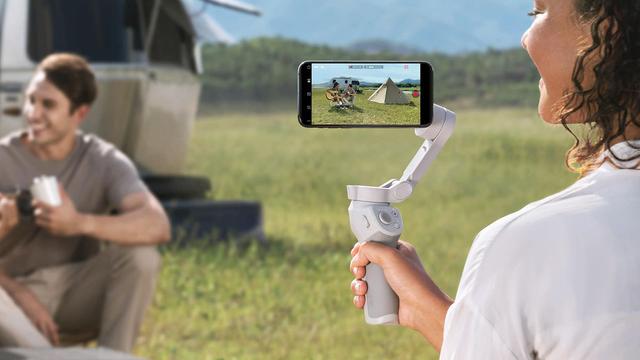How to use your smartphone like a GoPro
GO TO Travel has been lifted nationwide! Do you want to go somewhere? I like touring. Also low mountain hike. The autumn beach may be wonderful. While walking, live concerts of the autumn leaves and the waves coming to your feet. If I had such a delusion, I wanted a good camera ...!
The GoPro Hero 9 Black is an insanely cool action camera, but if you don't have the money to invest in it, you can shoot similar videos with your camcorder. Yes, the guy in that pocket. On your smartphone.
I'm not saying that the quality of smartphones is superior to GoPro, just in case. In most cases, that wins. If you want a compact, lightweight device that can be mounted anywhere and capture high-resolution, ultra-stable footage, GoPro is still your best choice. However, you can make a slight modification to the smartphone you are using now and use it as a substitute. What to do? Do this.
Try adding accessories
Video stability is indispensable for action cameras. Some of the finest flagship models, such as the iPhone 11 and Galaxy S20, are equipped with an unnecessarily high-performance image stabilization function, so check the functions that your device originally has. It's well worth seeing.
If your smartphone's image stabilization function is a little weak, try DJI OM 4 (about 15,700 yen), the industry's top gimbal. With a removable magnet, it is equipped with various functions such as automatic subject tracking, a variety of creative effects, as well as essential functions for gimbals, and of course, it also supports time lapse. When it comes to features and how much better video quality is, there's nothing better than that.
Zhiyun Smooth X (about 7,400 yen) is challenging this DJI gimbal at a price. For about half the price, you can remotely control your smartphone using Bluetooth and play forever with a dedicated app with many fun effects. The foldable and lightweight design makes it easy to carry around. It may not give as good a result as the DJI OM 4, but it's still a gimbal worth considering.
Clip-on lenses are also a good way to get a GoPro-like effect on your smartphone's camera. The Olloclip series has a good cost performance, and there is a wide variety of products such as super wide lenses and macro lenses that can capture perfect videos at any time. Most products are exclusively for iPhone or Samsung Galaxy smartphones, but general-purpose lenses such as fisheye macro lenses (¥ 5,080) are also available.

Moment fisheye lens (about 10,000 yen) should also be a candidate for consideration. The angle of view is 170 degrees. This is probably not the case with any lens that comes standard with smartphones. It is compatible with the latest iPhones, Pixel, Galaxy, OnePlus and other smartphones, and thanks to its excellent optical system, it works even in night mode.
The great thing about GoPro is that it's easy to attach to almost anything, from ski helmets to car hoods. Finding a similar attachment for your smartphone can be a daunting task, but it's not impossible if you look for accessories that are specific to your smartphone manufacturer or model. Not surprisingly, the more popular your smartphone is, the more accessories you will find.
VelocityClip's product lineup is the best, with a wide variety of mounts to suit your application and smartphone model. Not only for bicycles, helmets and automobiles, but also for chest and head straps, wherever you might want to attach a camera. The cheapest option is about 2,000 yen. In addition, the Armor-X product lineup is quite good, and you can get it from about 1,600 yen by combining cases and mounts according to the application.
Let's touch on the case as well. The case is the most affordable way to get the durability and defense of your GoPro action camera. Especially if your smartphone does not have waterproof / dustproof functions as standard, it is worth considering purchasing. There are plenty of choices for cases, and if you use popular models from Apple and Samsung, the number and types will increase. The Gear4, Speck, OtterBox, and Tech21 lineups are all something you'll want to explore in detail.
Supported by software
As for the software, it is a good idea to start with the original video editor application for GoPro (Android version / iOS version). It's an app designed primarily for uploading videos from real GoPro devices, but you can use it with videos taken with your smartphone as well. You can also add the GoPro logo to the end of the video to make it look as if it was shot with a GoPro.
The GoPro Video Editor doesn't allow frame-by-frame editing like traditional desktop apps, but you can crop and filter, crop and combine scenes, audio overlays, insert subtitles, and more. It's a great package because you can do all this with your mobile device.
Quik (Android / iOS) is also a GoPro video editor, but it gives you more control over the automation and wizards. Select the video (or photo) you want to edit, select one from the available theme templates, and let the app do the rest. It even selects the audio clip to overlay on top.
If you dig deeper into Quik, there are a few editing options available, such as adding text overlays, cropping video clips, and changing the clip speed as needed. You can quickly create professional-grade videos that match the mood you are aiming for. The ending title in this case will be Quik instead of GoPro (if you don't like it, you can turn it off).
Want a more advanced video production app? Filmic Pro (Android version / iOS version) is charged (1,840 yen), but it has many powerful functions and tools to make the video the best finish. Not only can you finely control settings such as white balance and saturation in real time, but you can also use many functions such as easy-to-use zoom control, slow motion, and time-lapse.
Adobe Premiere Rush (Android / iOS) takes a traditional timeline-based video editing approach, but it's still fast and easy to use. While designed to upload video clips to social media as quickly as possible, it also features features such as speed adjustment and audio overlays to create any video in any scenario. The app is free to use, but you'll be charged a monthly subscription fee of JPY 550 to use advanced features (free if you subscribe to Creative Cloud).
It's also important to familiarize yourself with the inherent functionality of the camera app that comes with your smartphone by default. In the case of Google Pixel, with video mode enabled, swipe in from the side of the screen and tap the setting icon (gear) to display various settings, one of which is "Video image stabilization". Leave this on.
For iOS, if your iPhone has an image stabilizer, this feature is always on. It cannot be turned off by the user. It is always valid. However, you can change related features and settings such as slow motion mode and recording resolution from "Camera" in the "Settings" menu.

![[Sumida Aquarium] November 11th is "Chinese Eel Day" "Gather! Connect! Chinese Eel Festival 2020"](https://website-google-hk.oss-cn-hongkong.aliyuncs.com/drawing/article_results_9/2022/3/28/6eacd09bd972d65c8e0a17147173d1ec_0.jpeg)

![[Celebration 10th Anniversary] “Stationery Shop Grand Prize 2022” announced! The grand prize is Sakura Crepas "Ball Sign iD Plus" 549 latest items selected by professionals](https://website-google-hk.oss-cn-hongkong.aliyuncs.com/drawing/article_results_9/2022/3/28/59f09e884c15a54929745f8b7cfa05ad_0.jpeg)



